9 Different Types Of Onions And The Best Ways To Use Them
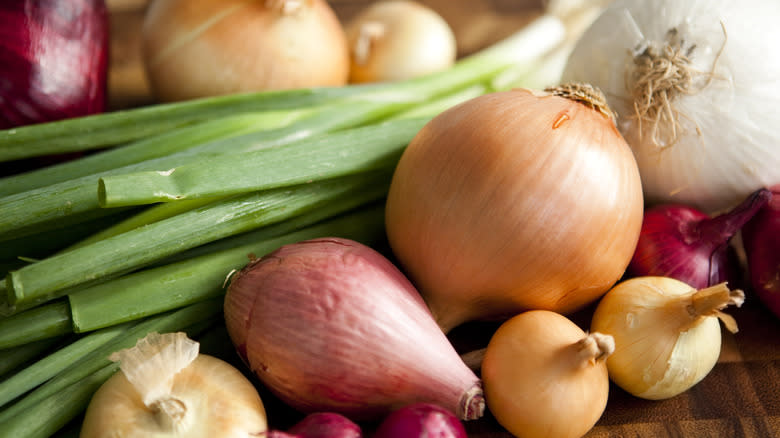
Onions are one of the most important vegetables in cooking. So many recipes either begin or end with the addition of onions, and they can take something bland and turn it into a dish that is bursting with flavor. But did you know that the type of onion you choose makes a big difference in how your food tastes?
The term "onion" can refer to numerous members of a genus of vegetables called Allium. This family includes leeks and garlic too, but it is largely made up of a wide variety of onions. Some are sweet, some are pungent, some are small, some are large, some are round, some are flat ... we could go on all day. All onions (the name of which comes from "union," thanks to all the united rings they are composed of) share a history that spans thousands of years, stretching back to prehistoric times, but each type of onion has traits and characteristics that are suited to certain dishes.
In ancient times, onions were thought to have magical healing powers, but now, we know that they mostly just make a darn good aromatic. Let's start peeling back the layers on this marvelous vegetable family and see which onions work best for which dishes.
Read more: 12 Vegetables And Fruits That Used To Look Very Different
Yellow Onion
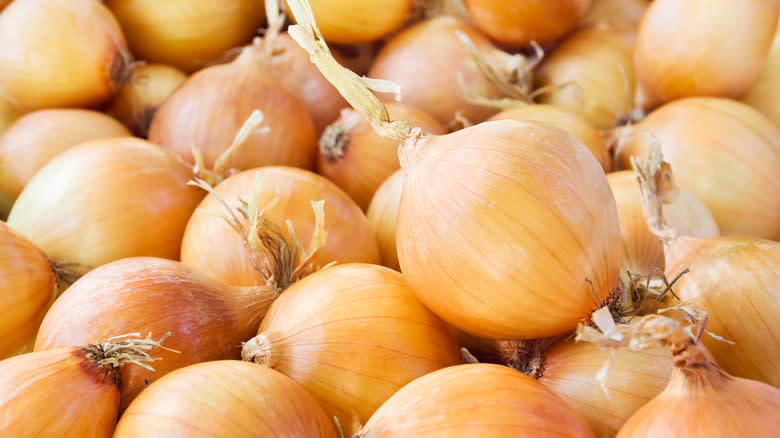
Yellow onions are your standard, go-to onions. Unless the recipe you are consulting says otherwise, this is the type of onion you should use. They can be found almost anywhere around the world and during all seasons. The yellow onion is a "storage onion," meaning that it can stay good for months after harvesting if it has been given a chance to dry out before being stored in a cool, dry, dark place. This type of onion has a paper-like skin that is a golden-brown color and which, when torn away, reveals a round, pale yellow bulb.
Yellow onions are particularly pungent and are known for their high concentration of sulfur. This makes them a bad choice for eating raw. They, in addition to red and white onions, are also the most likely of all the onions to make you tear up when you cut them, due to their defense mechanism that involves the release of sulfenic acid when they are sliced into. They are a fantastic type of onion to use for caramelizing, however, their strong taste becomes richer and less overwhelming as they cook slowly over a long period of time.
Sweet Onion
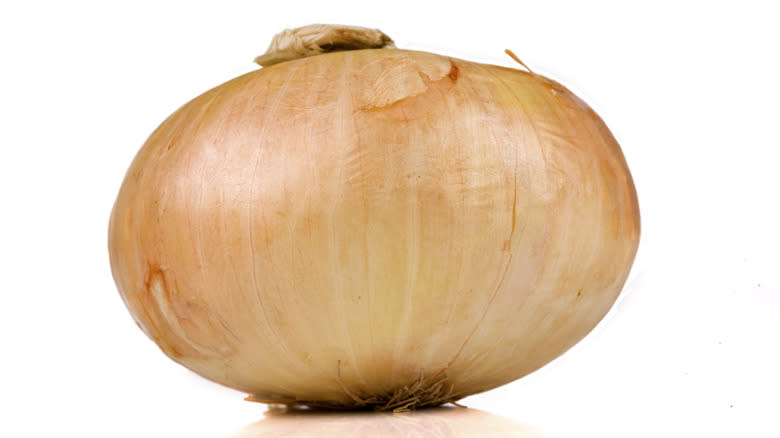
While yellow onions are too strong to eat raw, sweet onions were practically made for this purpose. This type of onion has much less sulfur than other onions, which means that not only can you slice it up and eat it without cooking it, but you most likely won't tear up when you're doing it. This trait isn't just left to chance, however. To produce onions with less sulfur, commercial farmers grow sweet onions in places like Vidalia, Georgia, where the soil naturally has very low levels of sulfur. Since the onions don't draw in much sulfur from the soil, they remain milder, sweeter, and easier to eat (and slice!). You can tell them apart from yellow onions by the fact that they have a flatter, more squished appearance and a slightly wider body.
Sweet onions make great uncooked additions to salads, sandwiches, and hamburgers. You can also cook them in dishes like focaccia or use them to make some deliciously sweet onion rings.
Red Onion
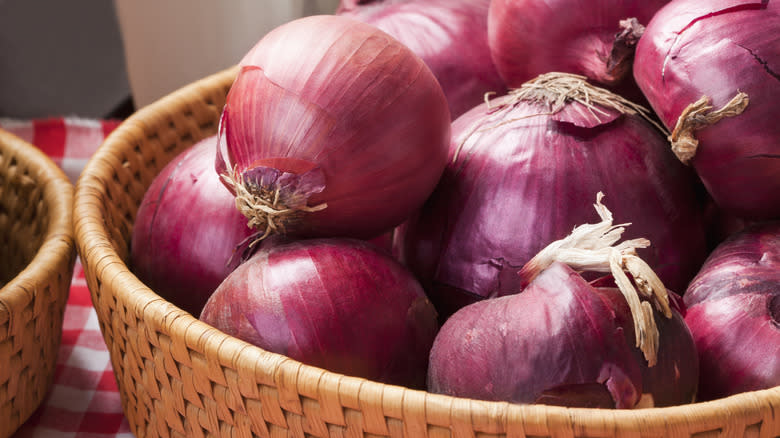
Red onions are also known as purple onions and are characterized by -- you guessed it -- their bold, purplish-red hue. This hue is so sought-after that it was once used to make red dye for clothing. Red onions are native to three vastly different regions of the world: Tropea, Italy; Turda, Romania; and Wethersfield, Connecticut. However, they have been spread around much of the rest of the world and are especially popular in North America and Europe. They can be found all year long and can be stored in a dry, cool place for up to three months, making them another good onion to keep around the house for when you need one.
Purple onions may make you cry when you cut into them, but they are well worth it. They are a very flavorful type of onion, with a sweet taste that makes them perfect for eating raw, in salads, or sliced up for guacamole. They can also be grilled or turned into caramelized onions to great effect, and they can even be pickled. There is just one drawback to these onions: they lose both the intensity of their flavor and the intensity of their color if they are cooked for extended periods or in slow-cooked dishes like soup or stew.
Green Onion
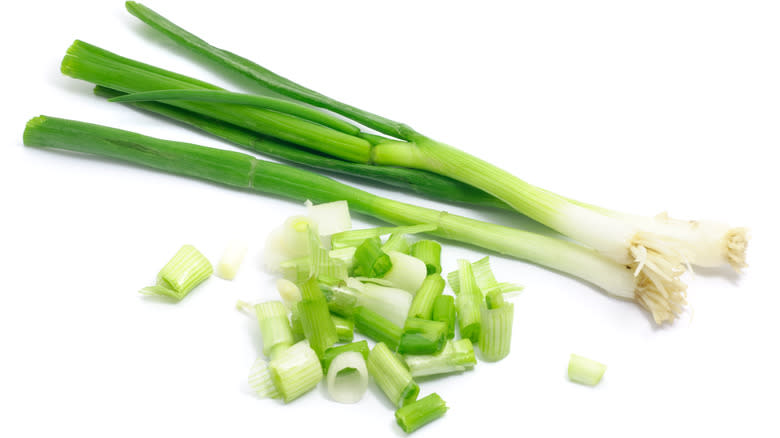
Would a green onion by any other name still taste as savory? This tiny type of onion has many aliases: scallions, bunching onions, Welsh onions, and Chinese onions, for starters. But whatever you choose to call it, it consists of a teeny tiny white bulb, much smaller than your standard red, yellow, or sweet onion bulb, and a long, hollow, tube-like set of green leaves. People often mistake green onions for spring onions, which look similar, but have a straight bulb instead of a rounded one.
Green onions are young onions that haven't grown up into the larger versions on this list just yet. Both their leaves and bulbs are edible, and they are an essential part of Asian cooking. In fact, in addition to appearing in many Chinese dishes like a stir fry, they are the only onion that is used in Japanese cuisine regularly. While they are most often used in Asian-inspired dishes, they can also be used raw as a topping for potato salads, egg salads, sandwiches, or as an ingredient in dips.
Be careful to note, though, that scallions don't last as long as yellow, red, and sweet onions. They must be stored in the refrigerator in a damp towel and eaten within two to three days.
Pearl Onion
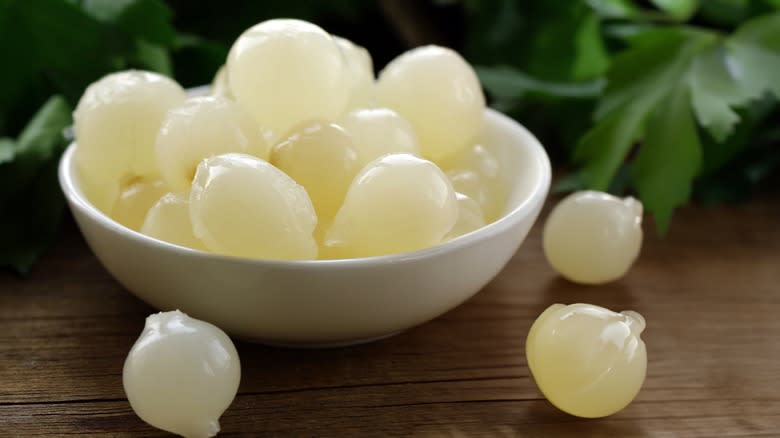
You may know pearl onions as "cocktail onions," a tiny onion used as part of a hors d'oeuvres spread, as an accompaniment to a particularly fancy meal, or in drinks. They have a lightly sweet flavor and come in a variety of colors. They can be eaten creamed, stewed, roasted, or glazed with tamarind or balsamic vinegar, or you can eat them raw. You can even use them as a garnish for martinis. They are also a popular onion for pickling.
Pearl onions often come in a jar and can be stored in a dry, well-ventilated area for up to four months if that jar has not been opened. Once it has, they can last for around two weeks in the fridge. It is also possible to buy pearl onions fresh, the same way you would other onions, and peel them yourself, although this is often reported as being difficult due to their small size. The key is to blanch them for two minutes in boiling water, then plunge them immediately into a bowl of cold water. The outer skin will then come off much more easily. Once you carry out this process, any uneaten onions must be stored in the fridge for around a week.
Shallot
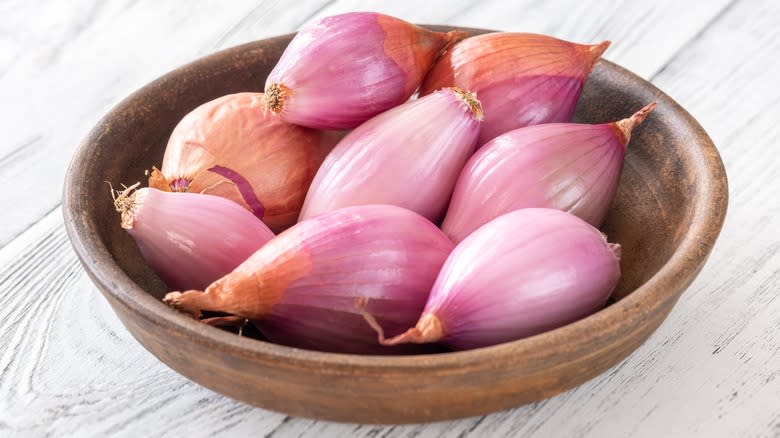
Shallots are recognizable by their unique shape. They have an almost crescent-like form more reminiscent of an enormous garlic clove than an onion, and their papery skin is usually either a brown or reddish color. These onions have a mysterious past, in that no one really knows where they originated. It is thought that they were first cultivated in Central Asia, but it is impossible to tell, especially as there are no wild strains of this onion to find. Now, though, they are pretty well spread across the world and make a great substitute for yellow onions.
When it comes to flavor, they have a less intense taste than yellow onions and are slightly sweeter, but they are still fairly pungent and strong. They work well raw in sandwiches and salad dressings, as well as for garnishes, but they really shine when they are roasted or braised.
Storage for shallots is also a bit different than other onions. The ideal way to do it is to place them in a paper bag or well-ventilated wicker basket and store them in a dry place for no longer than two months, but you can also refrigerate them for up to two weeks before they are cut.
Torpedo Onion
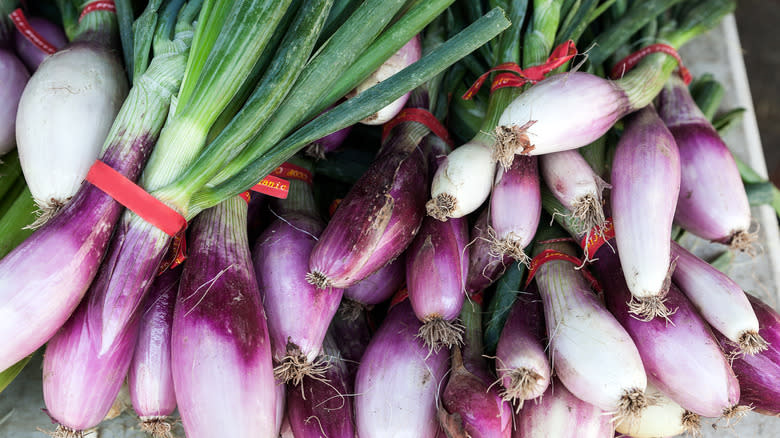
Torpedo onions are another type of onion that has an unexpected shape. These onions are long and slender, with firm, oblong bulbs and tightly wrapped red, papery skin. Once that skin is removed, the onion itself has a purple-white gradient that is quite pretty to look at. They hail from Italy, where they earned their name from the fact that they look very much like a torpedo -- something which, along with their mild taste, makes them very popular.
Torpedo onions are juicy, mildly sweet, and less smelly than other types of onions. They can be eaten in a wide variety of ways, including raw, on sandwiches or hamburgers, in dressings and dips, or roasted, sauteed, grilled, or braised. They are also a favorite pizza or focaccia topping and go well with many of the meat toppings used for these dishes. Unlike many other types of onions, torpedo onions are seasonal, and can be found from late winter through the end of summer.
Ramps
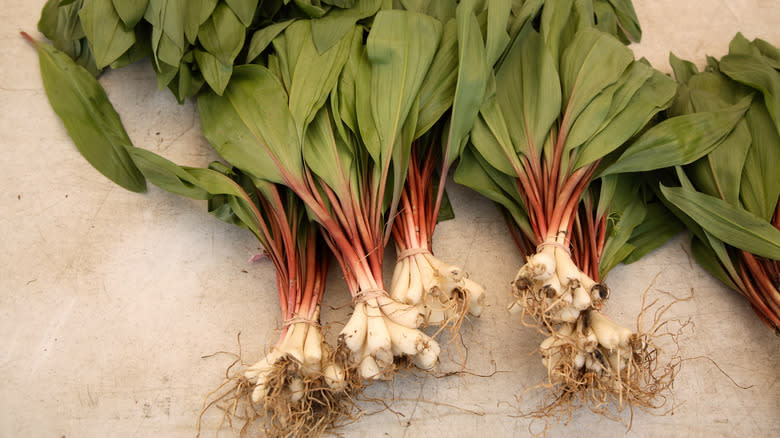
Like the very similar green onion, ramps go by many names, such as ramson, wild leeks, and (our favorite) Tennessee truffles. Every part of this onion can be eaten, including its leaves and stems. It is a favorite in pesto, but you may not recognize it at first. The raw form of ramps has a flavor more similar to garlic than to onions, but when it is cooked, it takes on a sweeter taste. These onions are best used as a garnish or fried.
While ramps are arguably one of the lesser-known onions, they are actually one of the first edible plants to spring up from the soil every spring. They don't last long, however, as they tend to grow to around 8 inches tall and then die when summer comes. Their seeds can take two years to germinate, making this one a challenging onion to grow. They can be found growing wild in several places in North America, including South Carolina, Minnesota, and Quebec, Canada, and are often sold at farmer's markets for a short time every spring. If you buy some, be sure to store them in a damp towel in the fridge, where they will only remain fresh for a week or less.
Cipolline
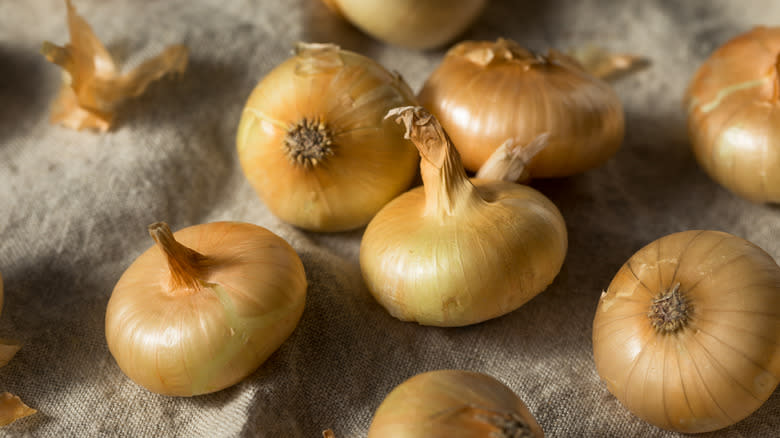
Cipolline means "little onions" in Italian, and the name could not be more accurate. Also known as Italian pearl onions, cipolline are flatter than their fellow onions and can come in either red or yellow varieties. They look much like sweet onions but are only around 1 inch tall and 1½ to 3 inches wide. While they are not quite as sweet as those sweet onions, they are milder than yellow onions. Since they are small, they are often roasted or grilled whole on skewers.
Cipolline, also known as cipollini onions or summer mini onions, are planted early in the spring and harvested in summer. They have a higher sugar content than some of the other onions on this list, so their storage method is different. You could try taking a pair of clean, disposable pantyhose and putting the onions inside them, trying a knot between each one so they can't touch. Then, hang up the pantyhose in a cool, dry place and cut each onion off this chain, at the knot, when you are ready to eat it.
Read the original article on Daily Meal.

